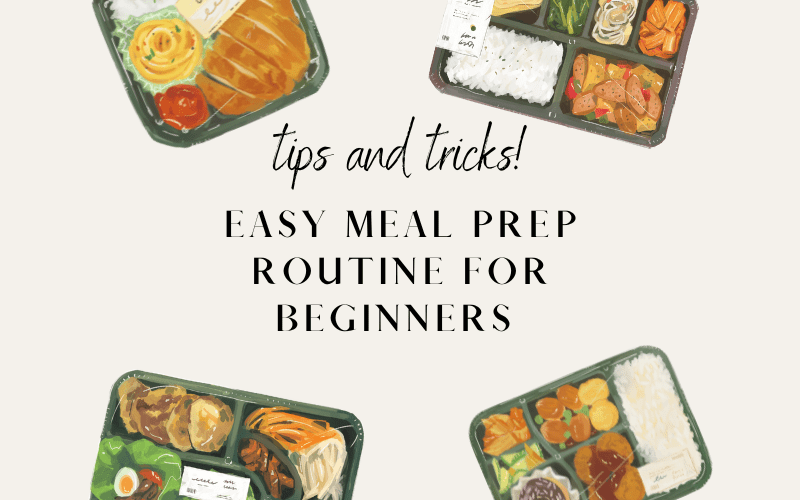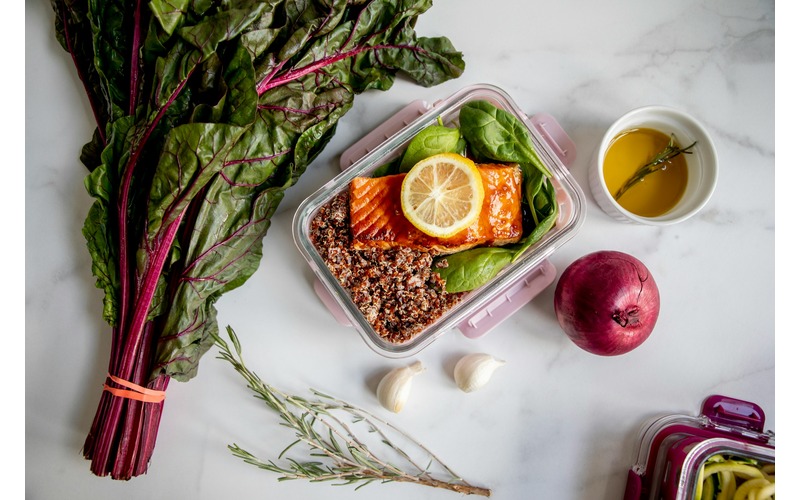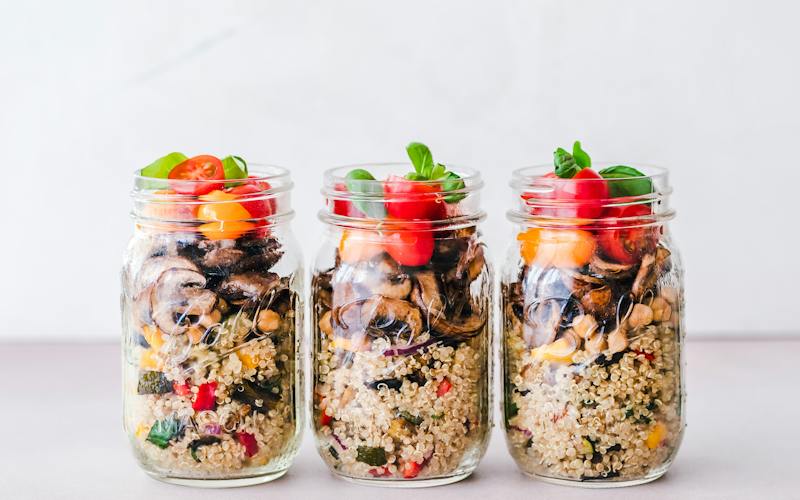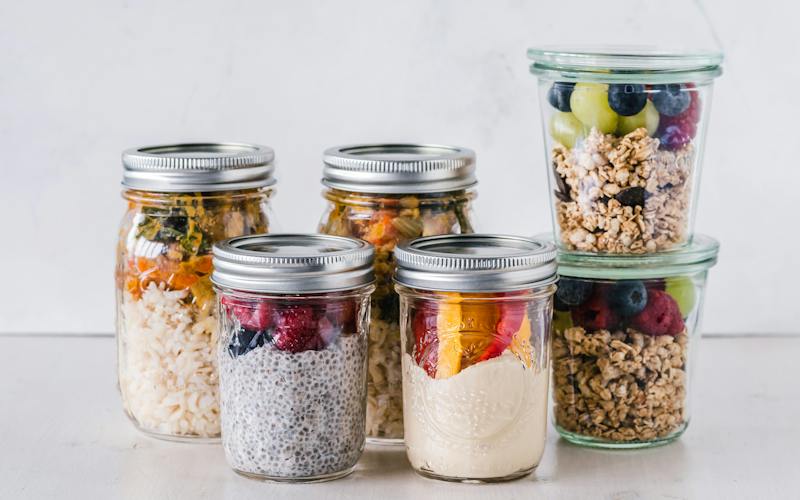
Table of Contents
INTRODUCTION TO MEAL PREPPING
Meal-prepping, a term that has gained significant traction in recent years, represents more than just a culinary trend; it’s a lifestyle choice that champions efficiency, health, and financial prudence. At its core, meal-prepping involves the strategic planning, preparation, and storing of meals for future consumption. This guide aims to demystify the process, making it accessible and appealing, especially for beginners.
What is Meal Prepping?
Meal prepping is preparing whole meals or dishes ahead of schedule. It’s prevalent among busy people because it can save a lot of time. Having pre-prepared meals on hand can also reduce portion size and help you reach your nutrition goals.
The Origin and Evolution
The concept of meal prepping is not new. It finds its roots in the age-old practice of planning and preparing meals in advance to save time and resources. However, with the advent of modern refrigeration and the fast-paced lifestyle of the 21st century, meal prepping has evolved into a more sophisticated and structured approach to managing one’s diet.
Why Meal Prep?
- Time Efficiency: Finding time to cook every day can be challenging in our fast-paced world. Meal prepping means you cook only once or twice a week, saving valuable time.
- Cost-Effective: Bulk buying and cooking can reduce your grocery bills. Also, it minimizes the temptation to eat out, further saving money.
- Healthier Eating Habits: Pre-planned meals can help you stick to your dietary goals and avoid last-minute unhealthy food choices.
- Reduced Food Waste: By planning and using ingredients efficiently, meal prepping can significantly cut down on food waste.

How It Works
The process typically involves selecting a day to prepare multiple meals, which are then portioned and stored for use throughout the week. This can range from full meals to pre-chopped ingredients that can be quickly assembled and cooked.
The Meal-Prepping Process: A Step-by-Step Guide
- Planning: Decide what you want to eat for the week. This involves choosing recipes and making a shopping list.
- Shopping: Buy all the ingredients you’ll need for your meal prep in one go.
- Preparation: Set aside a few hours to cook. This can involve making entire meals or just prepping parts of meals.
- Storing: Store your meals in containers. Refrigerate or freeze them depending on how soon you plan to eat them.
- Eating: Enjoy your pre-prepared meals throughout the week, reheating them if necessary.
Tools and Equipment for Effective Meal-Prepping
- Containers: Opt for BPA-free plastic or glass containers with tight-fitting lids.
- Basic Kitchen Equipment: A good set of knives, cutting boards, pots, and pans.
- Labels: Label your containers with the date of preparation.
Tips for Successful Meal Prepping
- Start Small: If you’re new to meal prepping, start with prepping just a few meals at a time.
- Keep It Simple: Choose recipes that are easy to make in bulk and that you enjoy eating.
- Variety is Key: To avoid getting bored, prepare a variety of meals.
- Mind the Shelf Life: Remember that different foods have different shelf lives.
BENEFITS OF MEAL PREPPING

In this section, we delve deeper into the tangible benefits of meal prepping, highlighting how this practice can positively impact various aspects of your life.
Time Management and Efficiency
Meal prepping is a time-saver par excellence. By dedicating a few hours to cooking at the start of the week, you reclaim hours that would otherwise be spent preparing meals daily. This efficiency extends beyond cooking time; it also reduces the time spent planning meals, shopping for groceries, and even cleaning up.
- Case Study: A 2019 study found that on average, individuals who meal prep report spending only 2-3 hours cooking per week, compared to non-meal preppers who spent upwards of 7 hours.
Financial Savings
One of the less obvious but equally significant benefits of meal prepping is the financial saving. Bulk buying ingredients often comes at a discounted rate. Moreover, by reducing the frequency of takeout meals and minimizing food waste, meal prepping can lead to substantial savings over time.
- Fact: The Bureau of Labor Statistics reports that the average American household spends approximately $3,000 per year on dining out. Meal prepping can significantly reduce this expense.
Healthier Lifestyle
Meal prepping allows for complete control over what you eat, how it’s prepared, and portion sizes. This control is crucial for those with specific dietary goals, whether it’s losing weight, building muscle, or simply eating healthier.
- List of Health Benefits:
- Portion Control: Helps in managing calorie intake.
- Balanced Diet: Ensures a well-rounded intake of nutrients.
- Reduces the Temptation for Unhealthy Options: Limits impulsive eating decisions.
- Customizable for Dietary Needs: Ideal for those with specific dietary restrictions or preferences.
Environmental Impact
Meal prepping can be a more sustainable way of eating. By planning meals and buying in bulk, you reduce the amount of packaging waste compared to individually packaged foods. Additionally, meal prepping helps in reducing food waste, a significant contributor to greenhouse gases.
- Statistical Insight: According to the EPA, food waste is responsible for approximately 24% of landfill input. Meal prepping can play a role in reducing this figure by encouraging more mindful food consumption and waste.
Psychological Benefits
The routine and organization of meal prepping can also offer mental health benefits. It brings a sense of order and control, which can be particularly helpful in times of stress or uncertainty. Knowing that your meals are prepared and ready can reduce daily decision fatigue and anxiety related to meal choices.
- Quote: “Meal prepping helps me feel in control of my health and schedule. It’s one less thing to worry about each day.” – Jane Doe, Nutritionist.
CHALLENGES AND SOLUTIONS IN MEAL PREPPING
While meal prepping offers numerous benefits, it’s not without its challenges. This section addresses common obstacles and provides practical solutions to ensure your meal-prepping journey is both enjoyable and sustainable.
Overcoming Boredom with Variety
Challenge: One of the biggest challenges in meal prepping is the monotony of eating the same meals. This can lead to boredom and a decreased interest in your meals.

Solutions:
- Theme-Based Meals: Rotate your meal themes weekly (e.g., Mexican, Italian, Asian cuisines).
- Mix and Match Components: Prepare a variety of proteins, vegetables, and grains that can be mixed and matched to create different meals.
- Seasonal Variations: Use seasonal ingredients to add variety and freshness to your meals.
Managing Time Effectively
Challenge: Finding time to meal prep, especially for beginners, can seem daunting.
Solutions:
- Weekend Prep Sessions: Utilize weekends or your days off for meal prepping.
- Quick and Easy Recipes: Start with recipes that are simple and quick to prepare.
- Batch Cooking: Cook in large batches to save time in the long run.
Storage and Shelf Life Concerns
Challenge: Properly storing prepped meals and understanding their shelf life can be confusing.
Solutions:
- Invest in Quality Containers: Use airtight containers to keep food fresh.
- Label Your Meals: Include the date of preparation on each container.
- Freeze for Longevity: Utilize your freezer for meals that won’t be eaten within a few days.
Nutritional Balance
Challenge: Ensuring each meal is nutritionally balanced can be tricky.
Solutions:
- Use a Food Planner: Plan your meals to include a balance of protein, carbs, and fats.
- Consult Nutritional Guides: Use online resources or consult a dietitian for balanced meal ideas.
- Diverse Ingredients: Incorporate a wide range of fruits, vegetables, whole grains, and proteins.
Cost-Effectiveness
Challenge: Keeping meal prepping cost-effective while maintaining variety and quality.
Solutions:
- Bulk Purchases: Buy non-perishable items and frequently used ingredients in bulk.
- Seasonal Shopping: Purchase fruits and vegetables that are in season to reduce costs.
- Limit Specialty Items: Use specialty ingredients sparingly to keep costs down.
Table: Common Meal-Prepping Challenges and Solutions
| Challenge | Solution |
| Monotony | Theme-based meals, mix and match components |
| Time Management | Weekend prep, simple recipes, batch cooking |
| Storage & Shelf Life | Quality containers, labelling, freezing |
| Nutritional Balance | Food planning, consulting guides, diverse ingredients |
| Cost | Bulk purchases, seasonal shopping, limit speciality items |
ADVANCED MEAL-PREPPING TECHNIQUES
For those who have mastered the basics of meal prepping and are looking to enhance their skills, this section delves into advanced techniques. These tips will help you streamline your process, introduce more variety, and maintain your enthusiasm for meal prepping.

Mastering the Art of Flavor Layering
Technique: To keep your meals exciting, learn the art of flavour layering. This involves using a combination of herbs, spices, and cooking techniques to create depth and complexity in your dishes.
Tips:
- Herb and Spice Combinations: Experiment with different herb and spice combinations to find flavours that excite your palate.
- Marinating: Use marinades to infuse proteins with flavour before cooking.
- Roasting and Grilling: These cooking methods can add a smoky depth to vegetables and meats.
Efficient Cooking Strategies
Technique: Develop strategies to make your cooking process more efficient and less time-consuming.
Tips:
- Parallel Cooking: Cook multiple components of your meals simultaneously. For example, roast vegetables while simmering a stew.
- One-Pot Meals: Utilize one-pot recipes to reduce cooking and cleaning time.
- Pre-Cooked Ingredients: Incorporate pre-cooked ingredients like canned beans or rotisserie chicken to save time.
Creative Use of Leftovers
Technique: Turn your leftovers into entirely new and exciting meals.
Tips:
- Reinvent Your Meals: Transform leftover roasted vegetables into a hearty soup or blend them into a sauce.
- Mix with Fresh Elements: Combine leftovers with fresh ingredients to create a new dish.
- Leftover Makeovers: Use leftover grains or proteins as the base for salads, bowls, or wraps.
Advanced Meal Planning
Technique: Take your meal planning to the next level by incorporating themed meal days or cooking challenges.
Tips:
- Themed Days: Assign themes to different days of the week (e.g., Meatless Monday, Taco Tuesday) to add variety.
- Cooking Challenges: Challenge yourself to use a new ingredient each week or to recreate a restaurant dish.
Table: Advanced Meal Prepping Techniques
| Technique | Tips |
| Flavor Layering | Herb/spice combos, marinating, roasting/grilling |
| Efficient Cooking | Parallel cooking, one-pot meals, pre-cooked ingredients |
| Leftovers Use | Meal reinvention, mix with fresh, leftover makeovers |
| Meal Planning | Themed days, cooking challenges |
SUSTAINING MEAL PREPPING AS A LIFESTYLE
Adopting meal prepping as a long-term lifestyle choice requires more than just a good understanding of the basics. It’s about creating a sustainable practice that aligns with your personal life, goals, and preferences. This final section provides insights on how to make meal prepping a rewarding and enduring part of your routine.

Building a Meal-Prepping Habit
Key to Sustainability: The secret to long-term success in meal prepping lies in habit formation. Making meal prep a regular part of your weekly routine ensures it becomes a sustainable practice.
Strategies:
- Set a Regular Prep Day: Choose a day each week dedicated to meal prepping, making it a non-negotiable part of your schedule.
- Gradual Expansion: Start with prepping a few meals and gradually increase as you become more comfortable.
- Involve Family or Friends: Make meal prepping a social activity to increase enjoyment and commitment.
Adapting to Life Changes
Flexibility is Key: Life is unpredictable, and your meal-prepping routine should be adaptable to accommodate changes in your schedule, dietary needs, or preferences.
Tips:
- Flexible Meal Options: Prepare a mix of freezable, refrigeratable, and quick-fix meals to cater to different scenarios.
- Adjust Portions as Needed: Change meal portions based on your current dietary goals or family size.
- Stay Open to New Ideas: Regularly seek out new recipes and techniques to keep meal prepping exciting.
Making Meal-Prepping Eco-Friendly
Environmental Consideration: As you integrate meal prepping into your lifestyle, consider its environmental impact and strive for eco-friendly practices.
Eco-Friendly Tips:
- Reusable Containers: Opt for durable, reusable containers to reduce plastic waste.
- Mindful Shopping: Purchase locally sourced and seasonal ingredients to reduce your carbon footprint.
- Minimize Food Waste: Plan your meals to use up ingredients efficiently and compost organic waste.
Embracing the Journey
Meal Prepping as a Lifestyle: Remember, meal prepping is more than just a method of food preparation; it’s a journey towards a more organized, healthy, and balanced life.
“Meal prepping is not just about saving time; it’s about loving yourself enough to give your body the nutrition it needs and your mind the peace it deserves.”
CONCLUSION
Meal prepping can be a transformative practice, bringing structure, health, and joy to your daily life. By embracing its principles and adapting them to fit your unique circumstances, you can make meal prepping a sustainable and rewarding part of your lifestyle.
Final Thoughts: As we conclude this detailed guide on meal prepping, remember that the journey is personal and adaptable. Whether you’re a busy professional, a health enthusiast, or someone looking to simplify their life, meal prepping has something to offer everyone. Embrace the process, enjoy the journey, and revel in the benefits that come with it.
If you found this interesting you might like: The Importance of Diet After 50

